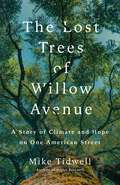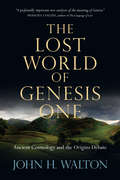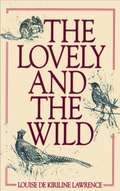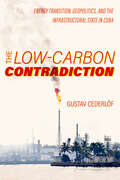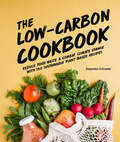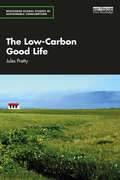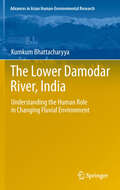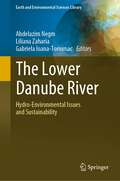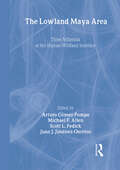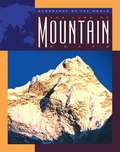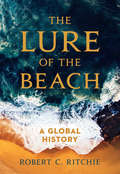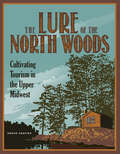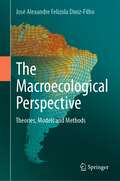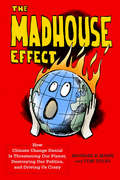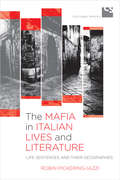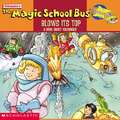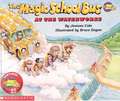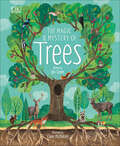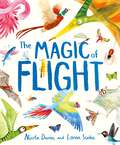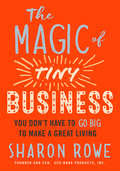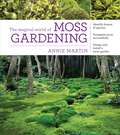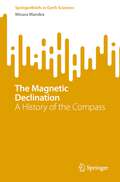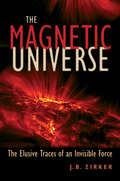- Table View
- List View
The Lost Trees of Willow Avenue: A Story of Climate and Hope on One American Street
by Mike TidwellA riveting and elegant story of climate change on one city street, full of surprises and true stories of human struggle and dying local trees – all against the national backdrop of 2023's record heat domes and raging wildfires and, simultaneously, rising hopes for clean energy.In 2023, author and activist Mike Tidwell decided to keep a record for a full year of the growing impacts of climate change on his one urban block right on the border with Washington, DC. A love letter to the magnificent oaks and other trees dying from record heat waves and bizarre rain, Tidwell's story depicts the neighborhood's battle to save the trees and combat climate change: The midwife who builds a geothermal energy system on the block, the Congressman who battles cancer and climate change at the same time, and the Chinese-American climate scientist who wants to bury billions of the world's dying trees to store their carbon and help stabilize the atmosphere.The story goes beyond ailing trees as Tidwell chronicles people on his block coping with Lyme disease, a church with solar panels on its roof and floodwater in its basement, and young people anguishing over whether to have kids –all in the same neighborhood and all against the backdrop of 2023’s record global temperatures and raging wildfires and hurricanes. Then there’s Tidwell himself who explores the ethical and scientific questions surrounding the idea of “geoengineering” as a last-ditch way to save the world’s trees – and human communities everywhere – by reflecting sunlight away from the planet. No book has told the story of climate change this way: hyper-local, full of surprises, full of true stories of life and death in one neighborhood. The Lost Trees of Willow Avenue is a harrowing and hopeful proxy for every street in America and every place on Earth.
The Lost World of Genesis One: Ancient Cosmology and the Origins Debate (The Lost World Series #Volume 2)
by John H. WaltonIn this astute mix of cultural critique and biblical studies, John H. Walton presents and defends twenty propositions supporting a literary and theological understanding of Genesis 1 within the context of the ancient Near Eastern world and unpacks its implications for our modern scientific understanding of origins.Ideal for students, professors, pastors and lay readers with an interest in the intelligent design controversy and creation-evolution debates, Walton's thoughtful analysis unpacks seldom appreciated aspects of the biblical text and sets Bible-believing scientists free to investigate the question of origins.
The Lovely and the Wild
by Louise De Lawrence Glen LoatesWinner of the 1969 John Burroughs Medal <p><p> From childhood Louise de Kiriline Lawrence dreamed of settling one day in an unspoiled, tranquil spot and living in harmony with nature. This beautifully written book is the story of her dream come true. <p> Truly a labour of love, The Lovely and the Wild is the product of an exceptional woman's profound joy at being part of the limitless world of nature. <p> Louise de Kiriline Lawrence passes over in a single sentence a fascinating life "which does not belong to this book." Born in Sweden, daughter of a naturalist, she served as a translator to an American military mission during the Russian Revolution, and was in charge of a Russian military hospital. She was a delegate of the Swedish Red Cross Expedition to the Volga region during the great famine of 1922 before emigrating to Canada.
The Low-Carbon Contradiction: Energy Transition, Geopolitics, and the Infrastructural State in Cuba (Critical Environments: Nature, Science, and Politics #13)
by Gustav CederlofIn the pursuit of socialism, Cuba became Latin America’s most oil-dependent economy. When the Soviet Union collapsed, the country lost 86 percent of its crude oil supplies, resulting in a severe energy crisis. In the face of this shock, Cuba started to develop a low-carbon economy based on economic and social reform rather than high-tech innovation. The Low-Carbon Contradiction examines this period of rapid low-carbon energy transition, which many have described as a "Cuban miracle" or even a real-life case of successful "degrowth." Working with original research from inside households, workplaces, universities, and government offices, Gustav Cederlöf retells the history of the Cuban Revolution as one of profound environmental and infrastructural change. In doing so, he opens up new questions about energy transitions, their politics, and the conditions of a socially just low-carbon future. The Cuban experience shows how a society can transform itself while rapidly cutting carbon emissions in the search for sustainability.
The Low-Carbon Cookbook & Action Plan: Reduce Food Waste and Combat Climate Change with 140 Sustainable Plant-Based
by Alejandra SchraderWINNER IN THE FOOD WASTE CATEGORY OF THE GOURMAND WORLD COOKBOOK AWARDS FOR THE UNITED STATESDiscover how to reduce the carbon footprint sitting on your dinner plateFrom the farmers to the delivery trucks and everything in between, there are countless people and processes involved in getting meat and produce from where they're made to your kitchen. This recipe book highlights the difficulties and pleasures of eating sustainably!If you're looking for a way to combat climate change from your kitchen, this cookbook will help you with your goals. It includes: • An introduction to the climate crisis and what the low-carbon diet is • Expert tips and advice on how to eat a low-carbon diet • Science-backed information on how to shop and cook smart by making the most-climate friendly choices • 140 plant-based recipes made with fresh, wholesome, and seasonal ingredients that can help you lower your carbon footprint and foodprint You may not think your food has anything to do with global warming, but in reality, the food industry has an undeniable impact on the environment and contributes one-fourth of our global greenhouse gas emissions. You can take a few small steps to help lower that number by introducing a low-carbon diet into your kitchen and life - and The Low-Carbon Cookbook will show you exactly how. Determining a food&’s carbon cost can be difficult. From examining the impact of the supply chain for foods to evaluating the carbon footprint of various plant-based options, this cookbook shows you exactly how to make the most environmentally friendly food choices. Packed with over 140 delicious recipes made with sustainable ingredients, this climate-friendly cooking book will teach you how to calculate your footprint, reduce your meat and dairy intake, and eat seasonal and local. • • • &“The Low-Carbon Cookbook is a welcome roadmap for home chefs of any level who care about the future of our planet and making conscious food choices. Alejandra Schrader blends detailed research with vibrant, delicious recipes that make eating a climate-friendly diet possible. With this delightful thought-provoking book, everyone can start making changes in how they eat today that will have a big impact on our planet tomorrow. In these times of climate crisis, this is a must-read for all who care about food, our climate, and all the living beings who share our planet.&” – Abby Maxman, president and CEO of Oxfam America &“When Alejandra writes about the relationship between the food we eat and the impact it has on the environment, she&’s not just doing it on a hunch—she&’s done the research and shares it in a way that&’s not polarizing or politicizing. By setting the table with food and facts, Alejandra provides anyone who cares about the food they eat with plenty of inspiration for creating meals that taste—and do—good.&” – Courtney Hazlett, executive producer and creator, Netflix&’s Restaurants on the Edge &“Our planet is in a crisis. Food systems are in a crisis. Rates of malnutrition—stunting and starvation and obesity—are on the increase. Many countries around the world have adopted farming and production patterns that are designed for convenient consumption and mass calories rather than the sustainability of the planet and good health. With more than 30,000 edible plants available on Earth, it&’s criminal we have come to rely on 3 crops for more than 60% of our calories. It&’s crucial we understand the relationship between nutrition and the health of our bodies—as well as planetary health—in order to care for our planet and to change food systems for the better. However, we can&’t talk about planetary health,
The Low-Carbon Good Life (Routledge-SCORAI Studies in Sustainable Consumption)
by Jules PrettyThe Low-Carbon Good Life is about how to reverse and repair four interlocking crises arising from modern material consumption: the climate crisis, growing inequality, biodiversity loss and food-related ill-health. Across the world today and throughout history, good lives are characterised by healthy food, connections to nature, being active, togetherness, personal growth, a spiritual framework and sustainable consumption. A low-carbon good life offers opportunities to live in ways that will bring greater happiness and contentment. Slower ways of living await. A global target of no more than one tonne of carbon per person would allow the poorest to consume more and everyone to find our models of low-carbon good lives. But dropping old habits is hard, and large-scale impacts will need fresh forms of public engagement and citizen action. Local to national governments need to act; equally, they need pushing by the power and collective action of citizens. Innovative and engaging and written in a style that combines storytelling with scientific evidence, this book will be of great interest to students and scholars of climate change, sustainability, environmental economics and sustainable consumption, as well as non-specialist readers concerned about the climate crisis.
The Lower Damodar River, India
by Kumkum BhattacharyyaInterweaving the human aspects of river control with analysis of hydro-physical data, including historical data over the last few centuries, this monograph is a comprehensive evaluation of the Damodar's lower reaches. While the Damodar River isn't an exceptional tropical river, nor does it feature classic examples of river control structures, it is unusual and worthy of study due to the fact that nowhere else in the tropical world have riverine sandbars been used as a resource base as well as for permanent settlements. Based on their knowledge of river stages, the inhabitants have fine-tuned their land use to flood events, applying a concept of flood zoning to the riverbed. Every available space has been utilized rationally and judiciously. This rare human-environmental study analyzes the remarkable way in which immigrants unfamiliar with the riverine environment have adapted to the altered hydrologic regime of the river. In doing so they have demonstrated a sophisticated understanding of the flood regime and the vagaries of an unpromising environment in their land use, cropping and settlement patterns. Spurred on by restricted social and economic mobility and sometimes political constraints, these self-settled refugees have learned to adapt to their environment and live with the floods. Bhattacharyya's text is particularly timely, as anthropogenic processes of this kind have not been adequately studied by geographers.
The Lower Danube River: Hydro-Environmental Issues and Sustainability (Earth and Environmental Sciences Library)
by Abdelazim Negm Liliana Zaharia Gabriela Ioana-ToroimacThis book provides essential information and recent findings on hydro-environmental issues in the Lower Danube River, particularly its hydrological and hydromorphological processes; physico-chemical features; climate and water-related hazards; and not only the biodiversity and quality but also the sustainable management and governance of its hydro-environment. Accordingly, it presents a broad range of scientific information on the lower sector of the second-longest river in Europe, which holds major economic importance and has been severely impacted by human pressures, especially since the second part of the last century. The engineering works (e.g. dams, reservoirs, levees, channelization, etc.) on the Danube and its tributaries, despite their benefits to society, have altered its flow and significantly reduced its sediment load, with consequences for hydromorphological processes and aquatic ecosystems. These ecosystems have also been affected by pollution from various sources. To promote sustainable management of the Danube River and its watershed, several strategies and measures have been developed by a number of institutions, from the European level to the national and regional levels (commissions, national authorities, non-governmental organizations, etc.). Compared to the upper and middle sectors of the Danube, the lower sector has received less attention in the international scientific literature in terms of hydro-environmental issues. The book fills this gap and provides current and original insights and findings from recent studies conducted by scientists from three countries drained by the Lower Danube River and its tributaries: Bulgaria, Romania and Serbia. This unique book will be of great scientific interest to professional engineers, policy planners and policymakers in the three countries mentioned above, helping them to implement their own sustainable development plans. It also offers a valuable resource for graduate students, researchers and stakeholders.
The Lowland Maya Area: Three Millennia at the Human-Wildland Interface
by Arturo Gómez-Pompa Michael F. Allen Scott L. Fedick Juan J. Jiménez-OsornioWhat can we learn from the people of the Maya Lowlands? Integrating history, biodiversity, ethnobotany, geology, ecology, archaeology, anthropology, and other disciplines, The Lowland Maya Area is a valuable guide to the fascinating relationship between man and his environment in the Yucatán peninsula. This book covers virtually every aspect of the biology and ecology of the Maya Lowlands and the many ways that human beings have interacted with their surroundings in that area for the last three thousand years. You'll learn about newly discovered archaeological evidence of wetland use; the domestication and use of cacao and henequen plants; a biodiversity assessment of a select group of plants, animals, and microorganisms; the area's forgotten cotton, indigo, and wax industries; the ecological history of the Yucatán Peninsula; and much more. This comprehensive book will open your eyes to all that we can learn from the Maya people, who continue to live on their native lands, integrating modern life with their old ways and teaching valuable lessons about human dependence on and management of environmental resources. The Lowland Maya Area explores: the impact of hurricanes and fire on local environments historic and modern Maya concepts of forests the geologic history of the Yucatán challenges to preserving Maya architecture newly-discovered evidence of fertilizer use among the ancient Maya cooperation between locals and researchers that fosters greater knowledge on both sides recommendations to help safeguard the future The Lowland Maya Area is an ideal single source for reliable information on the many ecological and social issues of this dynamic area. Providing you with the results of the most recent research into many diverse fields, including traditional ecological knowledge, the difficult transition to capitalism, agave production, and the diversity of insect species, this book will be a valuable addition to your collection. As the editors of The Lowland Maya Area say in their concluding chapter: If we are to gain global perspective from the changing Maya world, it is that understanding space and time is absolutely critical to human persistence. Understanding how the Maya have interacted with their environment for thousands of years while maintaining biodiversity will help us understand how we too can work for sustainable development in our own environments.
The Lure of Mountain Peaks
by Myra WeatherlyWhat makes so many people risk their lives to climb above the clouds? Young readers will learn how Aconcagua, Denali, Kilimanjaro, Mont Blanc, and Mount Everest came to be while they discover the beauty and allure of these mountain peaks.
The Lure of the Beach: A Global History
by Robert C. RitchieA human and global take on a beloved vacation spot. The crash of surf, smell of salted air, wet whorls of sand underfoot. These are the sensations of the beach, that environment that has drawn humans to its life-sustaining shores for millennia. And while the gull’s cry and the cove’s splendor have remained constant throughout time, our relationship with the beach has been as fluid as the runnels left behind by the tide’s turning.The Lure of the Beach is a chronicle of humanity's history with the coast, taking us from the seaside pleasure palaces of Roman elites and the aquatic rituals of medieval pilgrims, to the venues of modern resort towns and beyond. Robert C. Ritchie traces the contours of the material and social economies of the beach throughout time, covering changes in the social status of beach goers, the technology of transport, and the development of fashion (from nudity to Victorianism and back again), as well as the geographic spread of modern beach-going from England to France, across the Mediterranean, and from nineteenth-century America to the world. And as climate change and rising sea levels erode the familiar faces of our coasts, we are poised for a contemporary reckoning with our relationship—and responsibilities—to our beaches and their ecosystems. The Lure of the Beach demonstrates that whether as a commodified pastoral destination, a site of ecological resplendency, or a flashpoint between private ownership and public access, the history of the beach is a human one that deserves to be told now more than ever before.
The Lure of the North Woods: Cultivating Tourism in the Upper Midwest
by Aaron ShapiroIn the late nineteenth century, the North Woods offered people little in the way of a pleasant escape. Rather, it was a hub of production supplying industrial America with vast quantities of lumber and mineral ore. This book tells the story of how northern Minnesota, northern Wisconsin, and Michigan&’s Upper Peninsula became a tourist paradise, turning a scarred countryside into the playground we know today.Stripped of much of its timber and ore by the early 1900s, the North Woods experienced deindustrialization earlier than the Rust Belt cities that consumed its resources. In The Lure of the North Woods, Aaron Shapiro describes how residents and visitors reshaped the region from a landscape of exploitation to a vacationland. The rejuvenating North Woods profited in new ways by drawing on emerging connections between the urban and the rural, including improved transportation, promotion, recreational land use, and conservation initiatives. Shapiro demonstrates how this transformation helps explain the interwar origins of modern American environmentalism, when both the consumption of nature for pleasure and the work of the Civilian Conservation Corps in the North Woods and elsewhere led many Americans to cultivate a fresh perspective on the outdoors. At a time when travel and recreation are considered major economic forces, The Lure of the North Woods reveals how leisure—and tourism in particular—has shaped modern America.
The Macroecological Perspective: Theories, Models and Methods
by José Alexandre Diniz-FilhoThis comprehensive volume discusses the patterns and processes analyzed in macroecology with a distinct look at the theoretical and methodological issues underlying the discipline as well as deeper epistemological matters. The book serves as a synthesis of macroecological literature that has been published since Brown and Maurer proposed and defined the term “macroecology” in 1989. Author José Alexandre Felizola Diniz-Filho draws from the different disciplines and branches (ecology, evolutionary biology, physiology, behavioral sciences, climatology, and paleontology) that make up macroecology to present a full, holistic picture of where the discipline stands.Through ten chapters, Diniz-Filho moves from a discussion of what macroecology actually is to macroecological modeling to the more applied side of the discipline, covering topics such as richness and diversity patterns and patterns in body size. The book concludes with a synthesis of how macroecological research is done in a theoretical and operational sense as well as unifying explanations for each of the macroecological patterns discussed, moving on to evaluate which theories and models are still useful and which ones can be abandoned. The book is intended for academics, young researchers and students interested in macroecology and conservation biogeography. In addition, because of the integrative nature of macroecology and the theoretical and methodological background in the book, it can be of interest to researchers working in related fields including but not limited to ecology and evolutionary biology.
The Madhouse Effect: How Climate Change Denial Is Threatening Our Planet, Destroying Our Politics, and Driving Us Crazy
by Michael Mann Tom TolesThe award-winning climate scientist Michael E. Mann and the Pulitzer Prize–winning political cartoonist Tom Toles have been on the front lines of the fight against climate denialism for most of their careers. They have witnessed the manipulation of the media by business and political interests and the unconscionable play to partisanship on issues that affect the well-being of billions. The lessons they have learned have been invaluable, inspiring this brilliant, colorful escape hatch from the madhouse of the climate wars. The Madhouse Effect portrays the intellectual pretzels into which denialists must twist logic to explain away the clear evidence that human activity has changed Earth's climate. Toles's cartoons collapse counter-scientific strategies into their biased components, helping readers see how to best strike at these fallacies. Mann's expert skills at science communication aim to restore sanity to a debate that continues to rage against widely acknowledged scientific consensus. The synergy of these two climate science crusaders enlivens the gloom and doom of so many climate-themed books—and may even convert die-hard doubters to the side of sound science.
The Mafia in Italian Lives and Literature
by Robin Pickering-IazziUsing an array of cultural documents from 1990 to the present, including diaries, testimonies, fiction, online video postings, and anti-mafia social networks, Robin Pickering-Iazzi examines the myths, values, codes of behaviour, and relationships produced by the Italian mafia through a wide cross-disciplinary lens. The Mafia in Italian Lives and Literature explores the ways that these literary engagements with the mafia relate to broader contemporary Italian life and offer implicit challenges, and a quiet code of resistance, to the trauma and injustice wrought by the mafia in various Italian cities.Despite the long tradition of representing the mafia in Italian literature, until now women's contributions to this literature have been overlooked. Pickering-Iazzi's aim is to encourage new critical reflection on a broader selection of literature through new theoretical lenses in order to enrich our understanding of crime fiction, Sicily and Sicilian identity in literature, narrative traits of the new Italian epic, and the cultural and social functions of storytelling in life and literature.
The Magic School Bus Blows Its Top! A Book about Volcanoes
by Joanna Cole Gail HermanMs. Frizzle's class is having a hard time putting together a giant globe of the world. A piece is missing. . . an island so new it hasn't been discovered yet! Before they know it, the kids are beneath the oceans's surface, exploring an underwater volcano. Join the class as they learn about volcanoes.
The Magic School Bus Inside A Hurricane
by Joanna ColeMs. Frizzle is a grade school teacher who takes her class on fantastic field trips using her magic, metamorphosing school bus. In this installment, the class is heading for a visit at a weather forecasting center when they find themselves in the middle of a hurricane. Learning about weather and hurricanes ensues.
The Magic School Bus at the Waterworks (The Magic School Bus Ser.)
by Joanna Cole Bruce DegenNIMAC-sourced textbook
The Magic and Mystery of Trees (The Magic and Mystery of the Natural World)
by Jen GreenThis breath-taking ebook about trees takes children on a captivating journey of nature packed leafy exploration, showing them just how special these mighty organisms are. Discover how they communicate and warn each other of predators, how they nurture their networks, record the past, and anticipate the future to ensure their survival. There's so much more to trees than meets the eye. Learn about the amazing natural science of trees in this nature and science children's ebook. From the highest branches, all the down to the complex "wood wide web" of roots, every part of a tree plays an important role. Not only in its own growth but that of the whole ecosystem of the forest or woodland. Did you know that trees take care of each other and that a whole forest is connected?A truly delightful non-fiction read that is suitable for all ages - each page of this nature ebook is nothing short of astonishingly beautiful. Enjoy a mixture of real images, vibrant illustrations, and patchwork-layering, making each page feel like a nature scavenger hunt. You'll learn unbe-leaf-able tree facts, see extraordinary trees from around the world, and the animals that call them home. Find out what trees do for us and how we are damaging them with pollution and deforestation. This ebook will show that it's not too late to do something about it, and you'll find out how you can help with instructions on how to plant your very own tree!When you get to know these silent giants, you'll never look at trees the same way again.Discover The Secret World Of TreesDo you know that trees send underground messages? Have you heard that they take care of their families? A tree is so much more than it seems. The Magic And Mystery of Trees is the perfect introduction to the world of trees - above and below ground. Combining stunning photography with beautiful illustrations, turn the pages to find out how trees help prevent soil erosion, mark the seasons, and provide a habitat for wildlife - amongst other fun facts and amazing information about their role in nature.There are also some super fun, practical activities for kids! From planting your own tree to how to measure a tree&’s age, this ebook highlights the importance of trees to our planet through exciting hands-on activities. Children will begin to understand the importance of trees to our planet and take their first steps towards safeguarding them for future generations. Explore the secret lives of trees learning:- What they are- How they live- About their animal assistants- How to help trees- Tree defenses and senses, and much more!
The Magic of Flight: Discover birds, bats, butterflies and more in this incredible book of flying creatures
by Nicola DaviesOur skies are full of life! From bats and birds to bees and beetles, the air around us is buzzing with amazing flying creatures. Explore how and why animals fly, and the many ways in which this incredible ability has helped them flourish on our beautiful planet, in this beautiful book from award-winning non-fiction specialist Nicola Davies.Packed with fascinating facts and incredible illustrations to pore over again and again, this stunning large-format hardback is the perfect gift to inspire children to treasure our planet's precious biodiversity.
The Magic of Tiny Business: You Don’t Have to Go Big to Make a Great Living
by Sharon Rowe"This is a powerful book—tiny is mighty. Sharon Rowe's simple shift in thinking is a profound idea, precisely what we need to hear."—Seth Godin, author of LinchpinToo many of us feel trapped by work that keeps us from living our purpose. We fantasize about starting our own business, yet we're warned against falling into debt, working eighty hours a week, and coping with the pressure to grow. Eco-Bags Products founder Sharon Rowe says there's another way: go tiny. Like a tiny house, a tiny business is built on maintaining a laser focus on what is essential by living an intentional life. As an entrepreneur and mother, Rowe is most concerned with putting family first, maintaining financial security, and doing something that makes an impact in the world. Using the success story of Eco-Bags Products, Rowe distills the step-by-step process of building a profitable, right-scaled, sustainable venture that doesn't compromise your values. She shows you how to test your concept, manage your money and priorities, and more, while staying true to the "tiny" ethos.
The Magical World of Moss Gardening
by Annie Martin“This is a fascinating books for anyone wanting to truly broaden the range of plants they grow.” —Gardens Illustrated Moss is an extraordinary plant—it grows without roots, flowers, or stems. Despite being overlooked, in many ways, moss is perfect: it provides year-round color, excels in difficult climates, prevents soil erosion, and resists pests and disease. In The Magical World of Moss Gardening, bryophyte expert Annie Martin reveals how moss can be used in stunning, eco-friendly spaces. The beautifully illustrated guide includes basics on designing and planting a moss garden, as an inspiring tour of the most magical public and private moss gardens throughout the country.
The Magnetic Declination: A History of the Compass (SpringerBriefs in Earth Sciences)
by Mioara MandeaThis book aims then to describe in a comprehensible way efforts made over centuries of measuring and understanding the magnetic declination. The book also highlights some important characteristics of the Earth’s magnetic field thanks to the declination measurements. Some applications and societal implications are also underlined. Anyone living in the 21st century knows the best way to navigate is by using a smartphone App. Decades and centuries ago, in order to find the same way a magnificent instrument was used: the compass. Despite many being aware of the compass, not everyone appreciates that throughout the ages of exploration, sailors and explorers linked their lives and great discoveries to the magnetic needle. Furthermore, is there an awareness of the Earth’s physical mechanism behind the changes in time and space of the direction indicated by the compass? The magnetic declination is at the center of this book and it helps the reader to understand how to navigate in time and space. The book provides the history of the compass and magnetic declination leading the reader to the understanding of our magnetic planet.This book is designed for those who are fascinated by the long history of geomagnetism. This book relies on reader’s knowledge of elementary scientific concepts, and introduces the geomagnetism concepts as they evaluated in time. The focus is on some basic concepts and physical processes in order to understand the evolution of a specific element of the geomagnetic field, the declination. The primary audience may have just started an interest in the geomagnetism and history of science, as students and researchers. Some readers may have an interest that only touches the geomagnetism, as navigators, geophysicists, historians.
The Magnetic Universe: The Elusive Traces of an Invisible Force
by J. B. ZirkerA main selection of Scientific American Book ClubMagnetic fields permeate our vast universe, urging electrically charged particles on their courses, powering solar and stellar flares, and focusing the intense activity of pulsars and neutron stars.Magnetic fields are found in every corner of the cosmos. For decades, astrophysicists have identified them by their effects on visible light, radio waves, and x-rays. J. B. Zirker summarizes our deep knowledge of magnetism, pointing to what is yet unknown about its astrophysical applications. In clear, nonmathematical prose, Zirker follows the trail of magnetic exploration from the auroral belts of Earth to the farthest reaches of space. He guides readers on a fascinating journey of discovery to understand how magnetic forces are created and how they shape the universe. He provides the historical background needed to appreciate exciting new research by introducing readers to the great scientists who have studied magnetic fields. Students and amateur astronomers alike will appreciate the readable prose and comprehensive coverage of The Magnetic Universe.
The Magnetotelluric Method
by Alan D. Chave Alan G. JonesThe magnetotelluric method is a technique for imaging the electrical conductivity and structure of the Earth, from the near surface down to the 410 km transition zone and beyond. This book forms the first comprehensive overview of magnetotellurics from the salient physics and its mathematical representation, to practical implementation in the field, data processing, modeling and geological interpretation. Electromagnetic induction in 1-D, 2-D and 3-D media is explored, building from first principles, and with thorough coverage of the practical techniques of time series processing, distortion, numerical modeling and inversion. The fundamental principles are illustrated with a series of case histories describing geological applications. Technical issues, instrumentation and field practices are described for both land and marine surveys. This book provides a rigorous introduction to magnetotellurics for academic researchers and advanced students and will be of interest to industrial practitioners and geoscientists wanting to incorporate rock conductivity into their interpretations.
